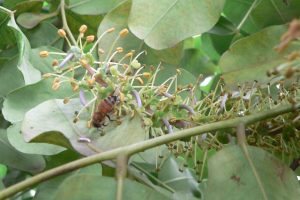Ceratonia siliqua
Carob, St John’s bread
Origin
Phylogenetic analyses have indicated the likely origin of the species to be the foothills of the High Atlas mountains in north west Africa. Spain is the biggest world producer but carob is now grown in many countries with similar climates.
Climate
It grows in lowland warm temperate and sub-tropical areas preferably with mild winters and hot, dry summers, although it can tolerate hot and humid conditions. Annual rainfall of only 250mm is sufficient for some fruit set. Growth is greatly reduced at <10°C. Mature trees can survive a mild, short frost.
Plant Description
Carob is an evergreen shrub or tree, 8-16m high. Leaves are pinnate with 3-9 pairs of glossy dark green leaflets. Second year leaves are shed in early summer with renewal the following Spring. It has a deep root system that enables it to obtain considerable nutrients and withstand long dry periods.
Relatives
Relatives include tamarind, African locust bean and other members of the large Fabaceae family (formerly called Leguminosae).
Soils
It is adapted to a wide range of soil types provided they are well-drained. Sandy soils are best, and even calcareous and quite sodic soils are suitable.
Propagation
Carob is difficult to propagate. Seeds have a very hard seed coat that severely impairs imbibition, & pre-treatment by mechanical or chemical (eg conc sulphuric acid for 30mins followed by thorough washing) scarification is necessary to improve germination rates & times. Seedlings can then be used for budding or grafting; cuttings have been inconsistent. Many superior cultivars have been selected in different countries and then maintained and distributed vegetatively. The US cultivar Clifford is hermaphrodite, bypassing the need to otherwise have multiple or doubly-grafted plants, and this cv is sometimes available in Australia.
Cultivars
Clifford grows & fruits well in Perth.
Flowering and Pollination
Carob is a dioecious species with some hermaphrodite forms. Inflorescences appear as short lateral racemes containing 15-40 small green-tinted and red coloured flowers mainly on 2 year old branches or on the trunk. Pistillate flowers consist of a pistil on a disk with rudimentary stamens and a bent ovary with 2 carpels and several ovules. Staminate flowers have a nectarial disk with 5 stamens, and hermaphrodite flowers have both a pistil and stamens. There are two types of staminate trees with either red or yellow anthers; the red types have a longer bloom period. There is some evidence that leaf form can be used to differentiate the 3 sexual forms in young plants, but the most definitive way to do this is to wait for flowering.
Pollination is effected by bees, flies, wasps and moths (70%) and wind (30%) with fruit set of 1-10%.
Cultivation
Traditionally, carob has been grown without intensive management, ie no irrigation or fertilizing, but regular N and K fertilization has been found to improve yield. Rainfall of more than 500mm pa is required for full cropping. Nitrogen fixing nodules are not present, but it does form an endo-mycorrhizal association that significantly assists plant nutrition.
Wind Tolerance
Young trees can be damaged by strong winds, and in mature trees branches may be broken and pods detached. However, planted at 2m separation, they make a fine tall windbreak, especially in conjunction with another shorter windbreak species.
Pruning
The basic open vase framework of the tree should be established when young and thereafter only light pruning after harvest is necessary to restrict size.
The Fruit
This is an indehiscent elongated straight or curved dark brown pod which can be up to 25cm long. When ripe, the outer layer is leathery and the dry pulp is soft and surrounds numerous transverse brown very hard seeds. The sweet pulp has a moisture content of 10%, good levels of fibre, antioxidants, thiamine, calcium and iron and contains 50% sugars.
Fruit Production and Harvesting
The seedling juvenility period is 6-8 years whereas grafted or budded plants may crop in half this time. Harvest is normally in summer. Fruit maturity when sugar content is maximal is indicated by a darkening of the pedicel just prior to abscising. Even under low-management conditions pod yield may be 50-70kg/tree. With such low moisture content the pods store well, even at room temperature.
Fruit Uses
The pulp can be eaten as a snack, but taking care to avoid the tooth-breaking seeds. Carob flour is used as a chocolate substitute in cooking. Commercially, the seeds are the most valuable product of the tree, or rather, the gum inside them, which is used by the food processing industry.
Pests and Diseases
Normally free of severe insect and disease problems. Nevertheless, the following may need to be managed – midges, moths and their seed-boring larvae, nematodes. leaf spot, powdery mildew, collar and fruit rot and Verticillium wilt. Parrots and cockatoos are also very fond of carob pods.
Comments
This tree has almost been designed for south west WA with its infertile coastal sands and hot dry climate. Indeed, carob was among the first fruit trees planted in Perth in the early 19th century, as a source of fodder for horses. Rows of carob street trees can still be seen in the older suburbs of Nedlands and Shenton Park.

